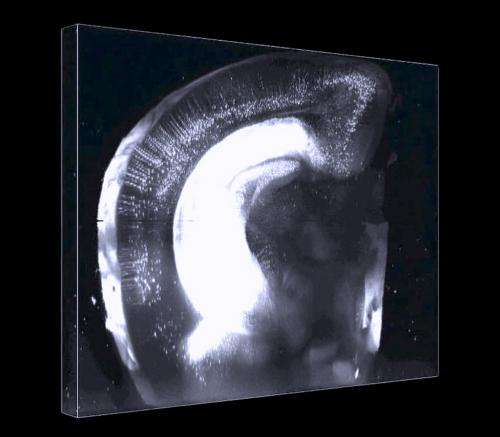Seeing the brain at greater depth

Brain tissue is opaque, so classical microscopy methods require slicing the brain into ultra-thin slivers to allow light to shine through. Techniques have been developed to enhance brain tissue transparency, but the chemicals used have a range of limitations. Takeshi Imai and colleagues from the Laboratory for Sensory Circuit Formation at the RIKEN Center for Developmental Biology have now developed a 'clearing' agent called SeeDB that resolves many of these limitations.
Existing brain clearing agents have a range of undesirable side-effects, such as causing the brain tissue to swell or shrink, quenching the signal of fluorescent probes used to label individual neurons, rendering the brain tissue very fragile and difficult to work with, or requiring very long incubation times to clear the brain tissue. Some of the existing methods also require special preparation methods that are prohibitive to most researchers.
Imai and his colleagues searched for a new clearing agent by testing various combinations of chemicals. The combination they found to be most effective consisted of the sugar fructose mixed with a thiol compound to prevent the tissue from turning brown or from fluorescing on its own. The researchers showed that this solution, called SeeDB (short for 'see deep brain'), could enhance the transparency of mouse embryos and young mouse brains. Moreover, despite adult brain tissue having fiber tracts that cannot be cleared by other methods, SeeDB was able to render adult mouse brains completely transparent. Another advantage of the new clearing agent is its ease of preparation, which allows researchers to produce and use it in their lab.
The researchers then used SeeDB to clear brain tissue from an adult mouse containing fluorescently marked neurons. Using a standard microscope lens and brain tissue incubated in SeeDB at room temperature, they were able to view 4 millimeters into the brain. Using a custom-made microscope lens and brain tissue incubated in SeeDB at body temperature, they were able to obtain images from the top to the bottom of the adult mouse brain, about 6 millimeters in depth (Fig. 1).
SeeDB will allow researchers to obtain clearer pictures of neuronal circuitry during development and disease in many species. The next challenge, notes Imai, will be to accelerate the imaging process. "With existing fluorescence microscopes, it takes a very long time—10 to 20 hours—to get images of just a part of the mouse brain," he explains. "The development of high-speed microscopes and computers for data analysis will be essential for large-scale imaging in the future."
More information: Ke, M.-T., Fujimoto, S. & Imai, T. SeeDB: a simple and morphology-preserving optical clearing agent for neuronal circuit reconstruction. Nature Neuroscience advance online publication, 23 June 2013 (DOI: 10.1038/nn.3447). dx.doi.org/10.1038/nn.3447



















